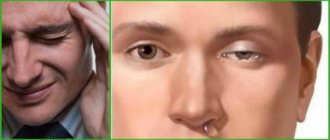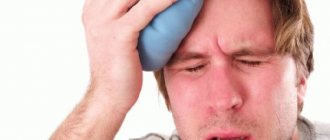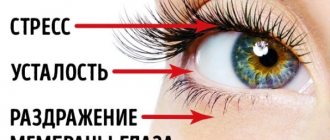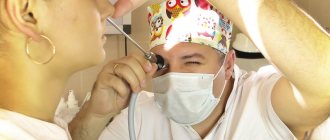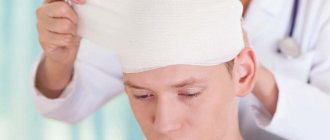Reasons why the left side of the head hurts
Headache on the left side can be caused by various reasons. It does not necessarily occur in diseases - painful sensations can also appear in healthy people due to stress or fatigue. Doctors at the Clinical Institute of the Brain advise you to go for an examination if the pain continues for more than 2-3 days in a row or bothers you too often. It is impossible to determine the exact cause at home or during a simple examination, but the doctor will need information about how the pain began, how long it lasts, in what area it occurs and with what intensity.
Physiological reasons
Even a healthy person, without any disorders or chronic diseases, can have a headache in the left area. If this symptom occurs once, is not very intense and goes away quickly, including after taking painkillers, there is no reason for concern. However, it is important to understand what can trigger a headache attack on the left side of the head in order to avoid such manifestations.
- Intense physical activity is the reason for accelerating blood circulation and activating the central nervous system. As a result, symptoms such as headache, dizziness and dark circles before the eyes, shortness of breath and tingling in the heart area may appear. To relieve them, a good rest is often enough; if the left side of your head hurts badly, you should take a painkiller tablet.
- Stress is one of the most common headaches. They arise as a result of increased concentrations of the hormones adrenaline, cortisol, angiotensin and others. They provoke vasoconstriction and increased blood pressure. To relieve pain, it is recommended to rest and resolve stressful situations, otherwise dangerous consequences are possible: chronic headaches, increased risks of stroke.
- Prolonged mental stress, including working at a monitor without breaks, can cause severe pain in the left area of the head. Constant concentration and tension, especially in a sitting position, is dangerous to health. Doctors recommend taking breaks of at least 5-10 minutes every hour and doing a light warm-up.
- Abuse of tonic drinks, which include tea and coffee, is one of the reasons why a healthy person may have a headache. They contain substances such as caffeine and tannin. These are plant components that cause a constriction of the blood vessels that supply the brain. This effect is often accompanied by an increase in blood pressure.
- Alcoholic drinks in large quantities are not a cure for headaches, but the cause that causes them. Ethyl alcohol first dilates blood vessels, and then provokes their sharp narrowing. Jumps in blood pressure are accompanied by pain, weakness and impaired heart function.
- Smoking is a source of nicotine, as well as hot vapors of other harmful compounds. This habit provokes the development of atherosclerosis, in which the lumen of the arteries narrows and they cannot supply enough oxygen to the brain. In addition, smokers often suffer from high blood pressure.
Most of the factors that cause pain in the left hemisphere of the head in a healthy person are related to habits and lifestyle. Doctors recommend completely giving up bad habits and spending time relaxing and walking in the fresh air. As a result, you can notice a significant improvement in your well-being and get rid of headaches.
Pathological conditions in which the left side of the head hurts
Pain on the left side of the head requires examination if it occurs frequently and is of high intensity. There are a number of reasons that can cause this symptom. These diseases can progress, so at the initial stage it is important to determine their cause and select an effective treatment regimen.
Migraine
An acute headache that occurs for no apparent reason and is highly intense is a migraine. During the examination, no functional impairment is observed, but it is known that this type of pain on the left side of the head is vascular in nature. Symptoms last from 4 hours to 3 days, and a migraine aura appears before the attack begins. It includes typical symptoms:
- nausea and vomiting;
- increased sensitivity to light, smells, auditory and tactile stimuli;
- numbness or tingling sensation on the skin of the face and hands;
- decreased visual acuity.
Statistically, women are more likely to suffer from migraines. Despite the fact that its primary cause has not been discovered, each patient has his own factors that can trigger another attack. This could be certain smells, foods, alcoholic drinks, extreme fatigue or stressful situations. You can relieve symptoms with painkillers, but they are not effective enough for migraines.
Tension headaches
Tension headaches are often symmetrical, but can also occur only on the left side. This is a complex of symptoms that develops due to stress, chronic fatigue, and muscle tension in the neck. One of the reasons why pain in the left head can occur on an ongoing basis is injuries in the cervical spine. The patient is concerned about characteristic manifestations:
- compressive pain that covers the temple and back of the head, spreading to the area behind the eyes;
- muscle tension in the neck and shoulder girdle;
- Symptoms increase towards the end of the day.
To get rid of pain in the head on the left, it is recommended to monitor your posture. Massage therapy can also help, but should be performed by an experienced professional, especially if there has been previous injury in the area.
Cluster headaches
Cluster headaches are considered the most intense and can significantly affect the patient's daily life. They arise in one part of the head or spread over its entire surface, often affecting the area behind the eyes, forehead and temple. Additional signs also appear:
- nasal congestion, difficulty breathing;
- ptosis - drooping of the eyelid;
- increased sensitivity to light in one eye, watery eyes;
- redness of the facial skin, increased sweating.
Cluster headaches are one of the rarest types. Their exact cause is unknown, but they often occur at regular intervals, in spring or autumn. The attack lasts for 5-10 minutes, and then the pain becomes less acute and persists for up to 3 hours. A characteristic sign of cluster pain is that it begins every day, at a certain time, for 1–3 months.
Diseases of the cervical spine
Pain in the left hemisphere of the head can be caused by diseases of the cervical spine. Here pass important vessels and nerves that carry blood and impulses to the brain. Their compression or inflammation leads to acute headaches, including unilateral ones.
- Osteochondrosis is a chronic disease in which degenerative changes occur in the cartilage layer between the vertebrae. They become less durable and elastic, and therefore lose their ability to absorb shock during movement. The space between adjacent vertebrae narrows, which leads to compression of blood vessels and nerves. Soreness manifests itself after a long stay in a sitting position or after exercise.
- Displacement of the vertebrae is a dangerous condition that leads to acute pain, inflammation of the nerves and compression of blood vessels. Most often this condition is associated with injuries, falls, or increased stress on the neck area, but in some patients the displacement can also occur in a calm state. In this case, congenital instability of the vertebrae and weakness of the neck muscles are important.
- Protrusion - protrusion of the intervertebral disc, the initial stage of a hernia. The process is accompanied by acute pain in the neck and one part of the head; any movement is difficult. The diagnosis can be made based on analysis of x-rays. The pain in the left hemisphere of the head goes away if the integrity of the spinal column is restored and the compression of blood vessels and nerves is relieved.
Chronic neck diseases require timely treatment as they can progress. The Clinical Institute of the Brain has all the conditions for a full diagnosis, as well as treatment and recovery from injuries, osteochondrosis, vertebral displacement and intervertebral hernias.
Atherosclerosis
Atherosclerosis is a chronic vascular disease that occurs when fat metabolism is impaired. Some products, including cholesterol, are not excreted, but accumulate in the blood and settle on the walls of the arteries. The vessels become fragile, insufficiently elastic, and cannot fully narrow or expand in response to increases and decreases in pressure. There are a large number of factors that can lead to the development of atherosclerosis, including:
- frequent consumption of fatty foods of animal origin (the main source of cholesterol);
- disruption of the secretion of enzymes that are involved in fat metabolism;
- liver diseases;
- overweight and sedentary lifestyle;
- smoking and alcohol abuse.
With atherosclerosis, a headache may occur on the left or right due to impaired blood supply to the brain. Painful sensations are often associated with increased blood pressure. The inability of the blood vessels to dilate and compensate for this condition leads to acute pain, dizziness, nausea and other alarming symptoms.
Traumatic brain injuries
Pain in the left hemisphere of the head can appear even long after injury. Concussions, bruises, open and closed craniocerebral injuries cause disruption of the blood supply to certain areas of the brain. Even in patients whose nervous activity is completely restored, pain may be felt after exercise and due to changes in weather. Injuries often trigger chronic migraines. The pain can be relieved with painkillers, and the doctor will help you choose the most suitable option.
Stroke
An acute headache on the left side of the head is one of the first signs of a stroke. In this condition, a sudden disruption of cerebral circulation occurs, resulting in areas of ischemia. The process can be determined at home, but it is important not to miss its first manifestations:
- acute headache, often one-sided;
- increase or decrease in blood pressure;
- pain in the heart area;
- asymmetry of movements of facial muscles and limbs;
- loss of consciousness.
The most common type is ischemic stroke. It occurs when there is an acute disturbance of cerebral circulation due to vascular disease or blockage. Atherosclerosis, stress and other factors can lead to an attack. Hemorrhagic stroke is less common, but is more life-threatening. It is accompanied by rupture of the vessel and the release of blood into the brain. It can accumulate in the brain ventricles or meninges, thereby provoking the appearance of areas of necrosis. Help for a stroke can only be obtained in a hospital, in an inpatient setting. Doctors at the Clinical Institute of the Brain emphasize that the highest probability of a favorable outcome remains if you seek help in the first 2 hours.
Neoplasms in the brain
Tumors and cysts can cause acute headaches, including unilateral ones. Neoplasms disrupt the processes of cerebral circulation, compress blood vessels and nerve tissue. The pain is chronic and always appears in the same area, but can spread to the entire surface of the head. The diagnosis is made based on CT or MRI data, and treatment tactics are selected individually. Early diagnosis of lumps is important because over time they can grow in size and cause more dangerous symptoms.
Colds
Colds and flu are common infectious diseases that appear more often during the cold season and in the off-season. The virus infects the upper respiratory tract and causes a persistent increase in temperature. Headache is also considered one of the characteristic symptoms. It is associated with pressure changes, high temperature, and also with the accumulation of exudate in the nasal sinuses. It decreases after rest and taking antipyretic drugs.
Arterial hypertension
Increased blood pressure is one of the main causes of headaches in the left area of the head. With hypertension, it is one-sided, pulsating, and can spread to the temple area or the back of the head. At home, you can measure your blood pressure using a tonometer. Normally, the result is about 120/80 mmHg; hypertension can be considered when the result is 140/90 mmHg. and more. An attack of hypertension may also be accompanied by additional symptoms:
- tinnitus, temporary deterioration in hearing and vision;
- rapid heartbeat;
- redness of the facial skin;
- painful sensations and discomfort behind the sternum.
Attacks of hypertension are often triggered by intense physical activity, stress and nervous tension. They appear more often in hot weather and in poorly ventilated areas. The pressure increases due to the need to increase the supply of oxygen to the cells. To normalize blood pressure, it is recommended to ventilate the room and take medicine.
Blown ear - symptoms
Ear pain is one of the most unpleasant.
If you have ear pain, it is almost impossible to endure it. In such cases, it is customary to say that the ear is blown. But in fact, the cause of pain is not the wind or the cold, but the inflammatory process that began “thanks” to these provoking factors. What are the symptoms of this pathology? Just a short time after you get a cold in your ear, you may feel that your hearing has begun to worsen, and you may feel a slight congestion of the ear canal on this side. To do this, it may be enough to walk with uncovered ears in a strong wind or sit indoors in a draft. And already towards evening the first painful sensations begin. which will become especially strong at night. Surprisingly, ear pain usually subsides during the daytime. However, if you do not take any measures, then at night she will return again. The nature of the pain can be aching, throbbing or, as they say, shooting. In the latter case, a person feels constant pain in the ear, then it increases abruptly and returns to its previous level.
The patient's general condition worsens, he feels weakness, lethargy, and body aches. He may experience chills and a fever. If you continue to not pay attention and try to simply endure the pain, for example, by taking some painkillers, then the lymph nodes may become enlarged, and discharge may appear from the ear canal. All this suggests that a strong inflammatory process is occurring in your body.
Methods for diagnosing pain in the left hemisphere
To determine why the left side of your head hurts, you will need a full examination. Neurologists diagnose diseases that can lead to this symptom. According to their recommendations, a number of examinations are carried out, the results of which can be informative in determining the cause of the headache and making a diagnosis:
- collecting medical history data - it is important for the doctor to know about the conditions for the occurrence of headaches, its nature and strength, as well as the patient’s lifestyle and habits, old injuries and diseases;
- Ultrasound examination of cerebral vessels (Dopplerography) is a method by which you can evaluate the speed of blood flow and the degree of filling of blood vessels;
- encephalography is a technique that allows you to examine the functional activity of the brain;
- MRI is one of the main diagnostic methods, more often used to identify tumors, but it is also informative for other pathologies.
At the Clinical Brain Institute you can undergo a full examination and determine the cause of your headache. The test results will show a complete clinical picture, on the basis of which it will be possible to select an individual treatment and prevention regimen.
What to do if you feel unwell
Many people don’t think about why cephalalgia appeared and start mindlessly taking pills. This approach is wrong. For hypertension, medications that lower blood pressure are appropriate. For weather dependence and vegetative-vascular dystonia, an integrated approach is required.
Painkillers are selected individually. They should stop the attack within 20-40 minutes. If the headache continues to hurt, it is recommended to discontinue the remedy and choose another one. The doctor prescribes tincture of ginseng or eleutherococcus. To increase venous tone, drops based on horse chestnut are appropriate.
For migraines and nervous disorders, adjusting the daily routine in combination with good nutrition gives results. For spinal pathologies, medications are prescribed in combination with physiotherapy, exercise therapy, massages, and spa treatment.
For sinusitis, sinus cleansing sprays, vasoconstrictors, antibiotics, or intravenous injections are used. Treatment of pain radiating from the right side of the ear is possible only after a diagnosis has been made. Analgesics mask the pain symptom, but do not eliminate the cause.
Treatment of left-sided headaches
Treatment is prescribed only based on the results of the examination. There are various techniques that can be used in the hospital and at home. So, in case of a sudden headache, doctors recommend ventilating the room, doing a neck and head massage, drinking water and taking a short rest. If the discomfort persists, you can take medicine. The most common recommendations from doctors against headaches include:
- painkillers that relieve acute pain - they can be taken at home, but should not be abused unnecessarily;
- antispasmodics - relieve vascular spasm and restore normal blood circulation;
- massage - it’s worth making an appointment with a specialist who will also show you how to reduce pain at home;
- physiotherapy is effective for osteochondrosis, neck diseases and during the rehabilitation period after injuries;
- specific treatment - you may need a course of drugs to strengthen intervertebral discs (chondrol protectors), drugs to normalize metabolism in atherosclerosis and other drugs to treat the underlying disease;
- surgical treatment is rarely used; it may be recommended in the presence of tumors, cysts and foci of sclerosis that interfere with the normal functioning of the brain and tend to increase in size.
The Clinical Brain Institute specializes in the treatment of diseases that manifest themselves as headaches. Qualified specialists of a wide and narrow profile work here, and there is also the opportunity to undergo a full examination, including specific techniques. There are different ways to get rid of a headache, but only a doctor can suggest the most effective and safe one.
Clinical Brain Institute Rating: 4/5 — 16 votes
Share article on social networks
Ear pain on one side - how to treat it
An experienced specialist will prescribe treatment depending on what exactly caused the pain in the head and ears.
Treatment options:
- If the outer ear is inflamed, the doctor will clear the ear canal of pus and instill special antiseptic drops. Vasoconstrictor nasal drops, antipyretic and antiallergic drugs may be prescribed. If the inflammation is caused by an infection, antibiotics and anti-inflammatory drugs will be prescribed.
- If you have a middle ear disease, you will be prescribed painkillers, anti-inflammatory and antibacterial drugs. Drops will be instilled into the nose to restore patency of the Eustachian tube.
- Before treating an inner ear infection, you may have surgery to remove the pus. Therapy includes antibiotics and painkillers.
- The wax plug is removed with a Zhanne syringe and the ear canal is washed. Sometimes medications are used to soften sulfur.
- If your eardrum is injured, call an ambulance immediately. Before she arrives, apply a wad of sterile cotton wool to your ear. Never use ear drops.
For example, chewing gum helps to cope with painful syndrome in the head and ears during takeoffs and landings of an airliner.
Symptoms of the inflammatory process are partially alleviated by a compress based on sunflower oil and propolis. Mix the ingredients, dab a towel into the mixture and apply to your ear and forehead. Keep it for 20-30 minutes.
In all other cases, listen carefully to how you feel. If pain in the head and ears occurs frequently and continues for more than one day, make an appointment with a doctor. He will diagnose the disease and tell you what to do next.
You will learn more about ear pain in this video:
Sinusitis
A disease in which one or more sinuses become inflamed is called sinusitis. The pathology is inflammatory in nature and develops as a complication of various bacterial or viral infections. Most often, this disorder is diagnosed in children and adolescents aged 4-15 years. Sinusitis is a whole group of diseases that are classified according to the location of the inflammatory process:
- Sinusitis is inflammation of the epithelium of the nasal sinuses of the upper jaw.
- Frontitis is a lesion of the mucous membrane of the frontal sinus.
- Ethmoiditis is sinusitis of the ethmoid bone cells.
- Sphenoiditis is a pathological process in the sinuses of the sphenoid bone.
Maxillary sinuses with sinusitis
With sinusitis, the patient experiences characteristic symptoms indicating the development of inflammation in the paranasal sinuses:
- There is an unpleasant sensation in the nose. Depending on the location of the lesion and the number of sinuses involved in the pathological process, the pain can be localized in the bridge of the nose, above the eye or between the eyebrows. In this case, the discomfort increases sharply when pressing on the inflamed area or when tilting the head.
- Cephalgia. The headache is dull or aching and gets worse in the evening.
- With sinusitis, there is often discomfort in the throat and ear area on the affected side.
- Impaired nasal breathing. Due to nasal congestion, the patient's voice acquires a characteristic nasal sound.
- With normal outflow of pus from the sinuses, the patient experiences yellowish-green or brownish discharge with an unpleasant putrid odor from the nose.
- Low-grade or febrile fever, weakness, chills.
Treatment for sinusitis should be aimed at stopping the inflammatory process and ensuring the free outflow of purulent exudate from the sinuses. For this, various antibacterial or antiviral drugs are used: Amoxicillin, Meropenem, Ceftriaxone, etc.
The drug Amoxicillin
If conservative treatment does not have an effect, then surgical drainage is performed. It is performed to cleanse the sinuses of pus and collect material to identify the pathogen. After the analysis, the specialist can select the most effective drug for the treatment of sinusitis.
Pain in the throat and ear on one side is a fairly common symptom, which may indicate the development of various diseases of the upper respiratory tract, hearing organs or lymphoid system. If any signs of pathology appear, it is recommended to consult a specialist.
Migraine
Most often in such cases, a diagnosis of migraine is made. This pain affects the left side of the head, the left eye and ear, and sometimes the forehead. When the painful sensation worsens, nausea, vomiting, trembling in the body, increased sweating may appear, and sharp flashes of light and noise can be very difficult to tolerate. During an intensifying migraine attack, even the olfactory receptors may be disrupted. Hallucinations of smell appear, for example, a person can smell a rotten egg and so on. Everything that is seen and felt during an exacerbation and pain can last for several hours, and in some cases for several days. The left side of the head, the left side of the face, the ear and the eye hurt excruciatingly. When the attacks end, severe fatigue and drowsiness sets in, and increased fatigue remains.
How to treat a blown ear using folk remedies
Traditional medicine also has many recipes for treating a cold ear. Here are the most effective of them.
Finely chop the onion, take a piece of gauze and make a tampon based on the onion, such a size that it fits freely at the beginning of the ear canal. Place this swab in your ear, and put on an insulating bandage on top.
Squeeze the juice out of fresh onions, heat it in a water bath to 37 degrees and drop it into the cold ear - about half a pipette. This helps to quickly get rid of pain.
Take a teaspoon of chamomile flowers and pour a glass of boiling water over it. Let it brew for half an hour, then strain. You need to rinse your ear with this infusion several times a day if it is blown.
And do not forget, if necessary, if there is no improvement, be sure to consult a doctor.


